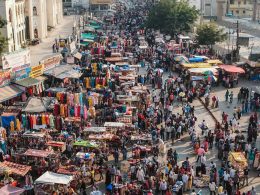by Mawer Investment Management, via The Art of Boring Blog
As you may recall, Argentina issued a 100-year bond last year. Aptly dubbed the “Houdini” bond, the issuance attracted a lot of attention from investors, not the least because Argentina has among the worst of investment reputations (see: experiencing triple-digit inflation in the 1980s and a deep economic depression in the late 1990s). As a country with a historic tendency to periodically stride into virulent populist policymaking, the recent 2015 Presidential election of centre-right Mauricio Macri was a welcome shift and had brightened some of Argentina’s economic prospects. But Argentina is back in the news and yet again facing a major financial threat.
We bring up Argentina’s past and current financial backdrop because it is a good reminder that investors must never neglect to understand the environment in which they are investing—even bottom up investors. Especially if you were looking to invest in a country for the first time.
Last year, while doing some research on Argentina, I compiled some questions that I now routinely use to assess a country’s macroeconomic position. These 15 questions are by no means exhaustive—they are not intended to be—but they serve as a helpful checklist for the main structural factors to consider when assessing a country’s macroeconomic backdrop. Each question serves as an umbrella for a certain line of thinking, and helps to assemble an overall picture.
It’s important to note that this list in no way supersedes our team’s fundamentally-bottom-up process: it is best considered as an add-on, a way of assessing the background risks and opportunities in a region. In my experience, these questions have also helped me get a quick handle on some of the macro risks and opportunities a company could face.
15 macro questions an investor should ask:
1. What are the core industries that make up and drive the economy, and how diversified are they?
While obvious, it’s important to understand what a country produces, who it sells it to, and to break down its main industries and which ones it excels at.
This can reveal important economic drivers, risks, and opportunities. For example, it is useful to know if a country is a heavy commodity producer like Canada or Saudi Arabia because then we can anticipate how its economy and currency might react should that commodity price soar or crater. Also, more mature and resilient economies also tend to be more diversified.
2. How is capital used in the economy?
A few years ago, Jim Hall went to India and observed (while stuck in traffic) a group of men trying to pick away at concrete on the side of the road with small hammers, instead of, say, a jack hammer. The situation was emblematic of the opportunity that India has to increase its productivity by increasing the use of capital. Some countries are further along in their capitalization than others and have productivity benefits from using machines and factories, whereas other countries rely more on labour.
Countries earlier in their capitalization path often have better growth opportunities.
3. What are the demographics and are they favourable for growth?
Demographics are useful to understand because they matter for growth. For example, the median age in Argentina is relatively young at 31.5, which is positive for the near-term economic momentum of the country. Conversely, the average age in Japan is 46.1, which creates a burden for the country’s growth and debt situation.
4. Is the country urbanized and, if not, is it expected to?
Countries that have yet to urbanize can see a pick-up in growth when they finally do. For example, China’s urbanization has driven growth in real-estate and construction while contributing to overall economic expansion. Geography can also be useful to understand in the context of national distribution. In Indonesia, for example, the number of islands creates unique barriers to entry in some industries. Finally, where people live can also impact centres of power: some cities and regions have disproportionately more power in a country, yield more political clout, and attract more capital and better labour.
5. Is the labour force productively structured?
Understanding the labour force of a country can be important when it comes to investing in individual companies. Some labour forces are mobile, educated, and productive, which usually makes for a positive business environment, while others are less so.
In Argentina, the labour force is remarkably rigid and unproductive: labour unions are dominant and powerful, often extracting double-digit wage increases every year, and labour laws are onerous. The net result is that Argentina is a place where it can be difficult to do business, and so investment is sometimes lacking. This compares markedly to a nation such as the United States which has a relatively flexible and productive labour force.
6. Do markets function freely or are there embedded structural features that are limiting (e.g., tariffs, subsidies, and government control)?
Argentina is an example of a country whose economic potential has long been mired because of limiting policies such as export and import tariffs and subsidies. For example, for years under the Kirchner administrations, Argentina subsidized the cost of natural gas to the consumer (Argentine homes are mostly gas heated). While a very popular program, it came at the expense of the local producers and distributors who struggled to be profitable in such an environment. Eventually, the difficult domestic climate led to a dearth of investment into Argentina’s otherwise bountiful energy assets, leading to inadequate domestic supply, which forced the government to start importing natural gas from Bolivia via pipelines just to meet demand.
Eventually, the consequences of this simple subsidy policy ballooned. Bolivian gas would go on to triple in price, which contributed to a massive budget deficit (along with other escalating social costs). And since the government had already defaulted on its debt in 2001 and could no longer tap foreign markets to fund the deficit, they turned to the central bank to print money. According to The Wall Street Journal, from 2007 to 2015, the central bank temporary advances and transfers on profits to the treasury shot from 4 billion pesos to 159 billion pesos. Unsurprisingly, this printing of money contributed to rising inflation. While inflation was 6% in 2009, it shot up to close to 25% by 2016! And all this because the government had implemented populist policies at a time when they were not creditworthy to foreign investment.
7. What does this country buy or sell from the Rest-of-the-World (RoW), and how important are these transactions to the country’s economic prosperity?
The trade patterns of a country are useful to understand because they reveal key areas of exposure. For example, the Canadian economy has a strong commodity base and relatively important agricultural, mineral, and energy industries. Because Canada sells these goods to the RoW, we are exposed to any country with an undue influence on the prices of these goods (i.e., China). Hence, the middle-income citizen in China is much more important to the prospects of many Canadian companies than one might reason if considering physical proximity. Trade is also useful to understand from a current account and currency perspective.
8. Who holds power and what is the power structure?
It is important to understand how power works both inside and outside the political system. For example, many companies in Far East Asia are controlled by powerful families (see: Korea). Investing in these companies is rather different than investing in a U.S. business where the main shareholder is a pension fund.
9. What is the exchange rate and monetary regime?
Many countries in the world now operate under a floating exchange rate regime and their central banks target some combination of modest inflation and full employment. However, not all monetary systems are organized this way. While floating rate regimes are common, many Middle Eastern countries and China control their currencies. And while central bank independence is commonplace, there are still many countries where the central bank is closely tied to the governing political party.
Understanding the exchange rate and monetary regime matters because currency and interest rates play such an important role in the overall economic system. As an example, there have been many historic examples of currency pegs being abandoned causing painful repercussions to investors. There have also been many situations where the central bank has printed money to finance government desires only to cause a spike in inflation (this happened to Argentina in the 2000s).
10. How much inflation is there and what is driving it?
Like Goldilocks’ breakfast, inflation is best when it is done just right. Anemic inflation or deflation can cause problems such as we’ve seen in Japan. In comparison, high inflation rates erode equity returns and the purchasing power of citizens. High inflation can also lead to distortions in the banking sector. As an example, did you know that less than 10% of houses are purchased using mortgages in Argentina? This is in part because banks have historically been reticent to make long-term loans because of the exorbitant inflation rate.
11. How developed is the country’s credit market and where are they in the credit cycle?
This is perhaps one of the most important questions. Credit is a pivotal part of any economy. The availability of, and access to, credit is strongly related to how a country can develop and grow. Countries that are very early in their overall debt profile and credit curve usually have greater-than-average economic growth opportunities. Also, credit booms and busts are related to market booms and busts. When something happens to the credit market and it shuts off, economic growth usually falters.
12. How is the banking system structured—is it stable, functioning, and free of bad assets?
As the epicenter of the credit market for virtually all economies, the banking system is crucial. Are banks able and incented to lend to the parts of the economy that need it? Are they exposed to any bad assets that might shut down credit or cause a banking crisis?
13. Does the government run a budget deficit? And to what extent do they rely—and are able to encourage—foreign debt financing from RoW?
Governments that run fiscal deficits need to finance them somehow. Most governments finance these deficits through foreign bond issuance to the RoW. However, some countries do this more easily than others. For example, the U.S. is in a superior borrowing position than many other nations because the USD is the world’s reserve currency. Compare this to Argentina, which has had a large fiscal deficit for years. Recently, they have financed this position through large amounts of external borrowing. The precariousness of this borrowing was made obvious recently when creditors started to lose faith in Argentina’s position (causing the peso to plummet and foreign capital to flee).
14. Is there trust in society, or is distrust and corruption rampant?
Trust is the fabric that allows commerce to function. When trust is poor in a society, like in Argentina or Indonesia, there can be economic consequences. Corruption is widely considered a constraint on economic growth and development. In societies where trust is low, business can still be conducted, and returns can still be attractive, but shareholders must be aware of the ways they could be swindled and how this corruption can impede overall development.
15. How large is this country’s economy relative to the RoW and what, if any, role does it play in the international economic order?
Very small players are often at the mercy of larger players. Small countries often have disproportionally important export sectors: when their main exporting patterns sniffle, they catch a cold. Another reason why size matters is because of capital flows. When countries experience large capital flows relative to the size of the economy, it can be disorienting. For example, 30% of our Canadian bond market is owned by foreigners. While unlikely, if one day foreigners became afraid of Canadian bonds (or we lost our credibility), a major Canadian bond market rout could unfold if they rushed out the door.
This post was originally published at Mawer Investment Management














